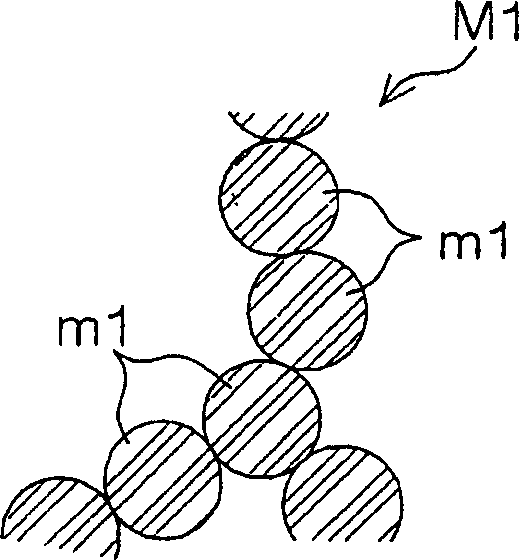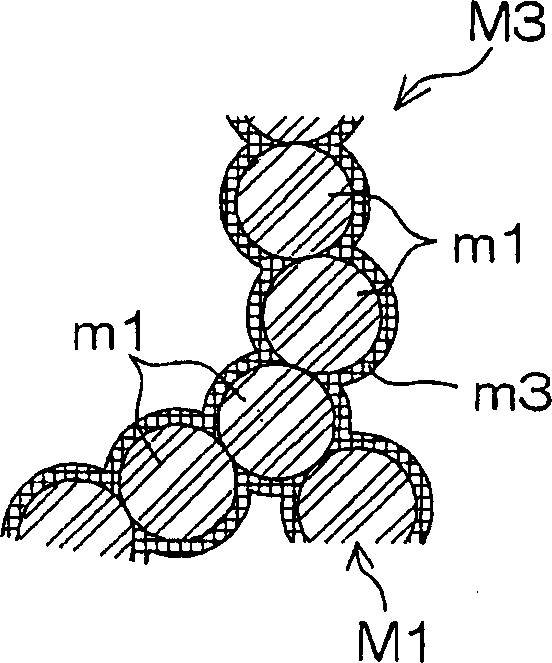Conductive paste and conductive film using it, plating method and production method for fine metal component
A conductive thin film, fine metal technology, used in semiconductor/solid-state device manufacturing, electrical components, conductive materials dispersed in non-conductive inorganic materials, etc., can solve through hole pattern deformation, mold damage, and fine metal components repeatability Reduce and other problems to achieve the effect of high conductivity
- Summary
- Abstract
- Description
- Claims
- Application Information
AI Technical Summary
Problems solved by technology
Method used
Image
Examples
example 1
[0247]
[0248] Titanium trichloride and sodium citrate were added to pure water to prepare a reducing agent solution, in which the concentrations of the two components adopted the values shown in Table 1 below:
[0249] Table 1
[0250] Component Concentration (mol / L)
[0251] Titanium trichloride 0.102
[0252] Sodium citrate 0.306
[0253] Ammonia water is then added to the reducing agent solution to adjust the pH of the reducing agent solution to 9 to 10 while maintaining its liquid temperature at 35°C.
[0254] Further, nickel chloride hexahydrate was added to pure water to prepare a solution in which the concentration of nickel chloride was 0.04 mol / L.
[0255] After adding 100 ml of reducing agent solution to 100 ml of this solution, as described above, followed by stirring at a temperature of 35° C. for one hour, the solid components precipitated in the solution were filtered, rinsed, and then dried to produce Ni powder .
[0256] When th...
example 2
[0274]
[0275] Nickel chloride hexahydrate and ferric chloride were added to pure water to prepare a solution in which the concentrations of the two components adopted the values shown in Table 2 below:
[0276] table 3
[0277] Component Concentration (mol / L)
[0278] Nickel chloride 0.008
[0279] Ferric chloride 0.032
[0280] To 100 ml of this solution was added 100 ml of the same reducing agent solution as used in Example 1, followed by stirring at 35° C. for one hour, and the solid component precipitated in the solution was filtered, rinsed, and then dried for Permalloy [Ni(20%)-Fe alloy] powder is produced.
[0281] When the shape of the obtained permalloy powder was observed with a scanning electron microscope, as Figure 9 As shown, it was confirmed that the permalloy powder had the form of fine metal particles connected in a chain shape.
[0282] When the diameter of each metal particle and the chain diameter of the permalloy p...
example 3
[0291]
[0292] The same conductive paste as prepared in Example 1 was applied to one surface of the polyimide film used as a substrate so that the amount of solid content attached was 20 mg / cm 2 , and then apply a magnetic field with a strength of 79 A / m to the coating film along its plane and bake it at 100° C. for four hours to remove the solvent, thereby forming a conductive film.
[0293] In this conductive thin film, the chain-like Ni powder is oriented in the above-mentioned direction of the magnetic field, and has high electrical conductivity only in the direction of its in-plane orientation. That is, the volume resistivity in the direction of the orientation of the chain Ni powder in the plane of the conductive film exhibits 5×10 -5 The low value of Ω·cm, while the volume resistivity in the direction perpendicular to the orientation direction in the same plane is 3×10 -3 Ω·cm, while the volume resistivity in the thickness direction of the conductive film is 2.5×10 ...
PUM
| Property | Measurement | Unit |
|---|---|---|
| diameter | aaaaa | aaaaa |
| diameter | aaaaa | aaaaa |
| electrical resistivity | aaaaa | aaaaa |
Abstract
Description
Claims
Application Information
 Login to View More
Login to View More - R&D
- Intellectual Property
- Life Sciences
- Materials
- Tech Scout
- Unparalleled Data Quality
- Higher Quality Content
- 60% Fewer Hallucinations
Browse by: Latest US Patents, China's latest patents, Technical Efficacy Thesaurus, Application Domain, Technology Topic, Popular Technical Reports.
© 2025 PatSnap. All rights reserved.Legal|Privacy policy|Modern Slavery Act Transparency Statement|Sitemap|About US| Contact US: help@patsnap.com



